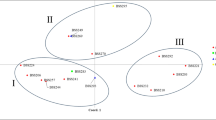Abstract
The development and mapping of genetic markers based upon expressed sequence tag polymorphisms (ESTPs) in loblolly pine (Pinus taeda L.) are reported. The new markers were generated by PCR-amplification of loblolly pine genomic DNAs with primers designed from sequenced cDNAs. The cDNA libraries were constructed from RNAs expressed in the needles of loblolly pine seedlings or in the xylem from young trees. DNA polymorphisms were identified by analyzing the amplified products for differences in fragment size or restriction sites, or by examining mobility differences using denaturing gradient gel electrophoresis (DGGE). DGGE revealed more DNA polymorphisms than the other two methods. Fifty six ESTPs were mapped using either of two mapping populations and positioned onto a loblolly pine consensus genetic map. Unlike many other markers commonly used in forestry, ESTPs can be used as orthologous markers for comparative mapping, to map genes of known function, or to identify candidate genes affecting important traits in loblolly pine.
Similar content being viewed by others
Author information
Authors and Affiliations
Additional information
Received: 10 April 2000 / Accepted: 13 July 2000
Rights and permissions
About this article
Cite this article
Temesgen, B., Brown, G., Harry, D. et al. Genetic mapping of expressed sequence tag polymorphism (ESTP) markers in loblolly pine (Pinus taeda L.). Theor Appl Genet 102, 664–675 (2001). https://doi.org/10.1007/s001220051695
Issue Date:
DOI: https://doi.org/10.1007/s001220051695




